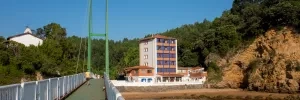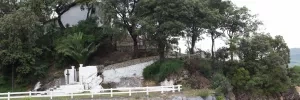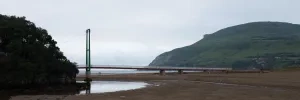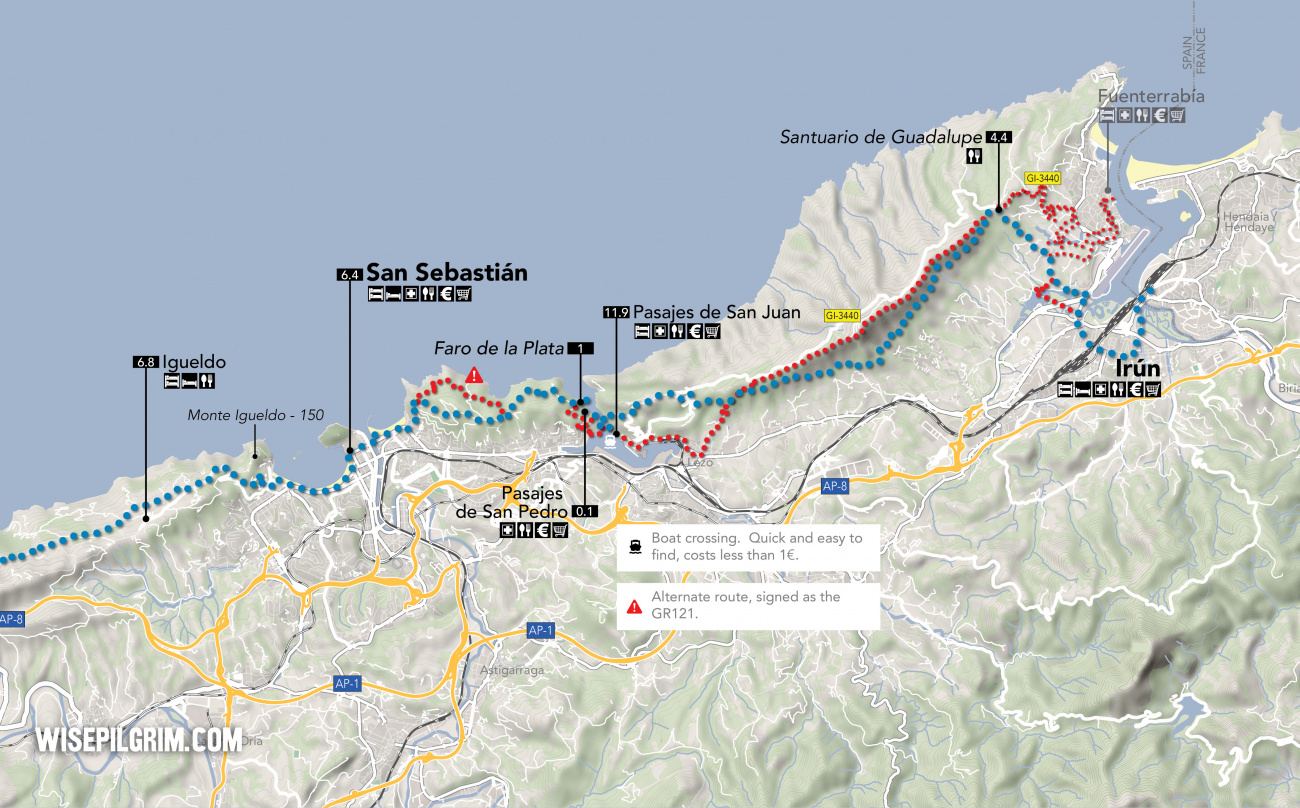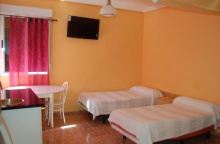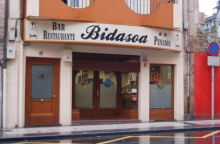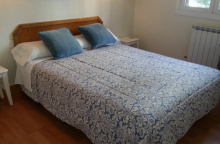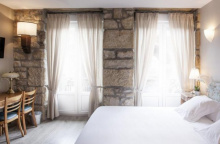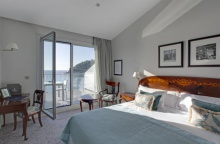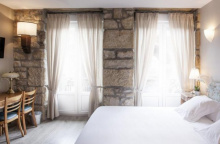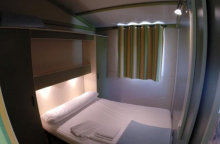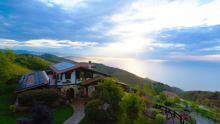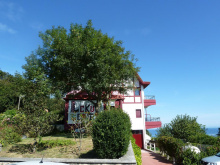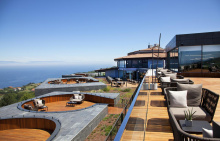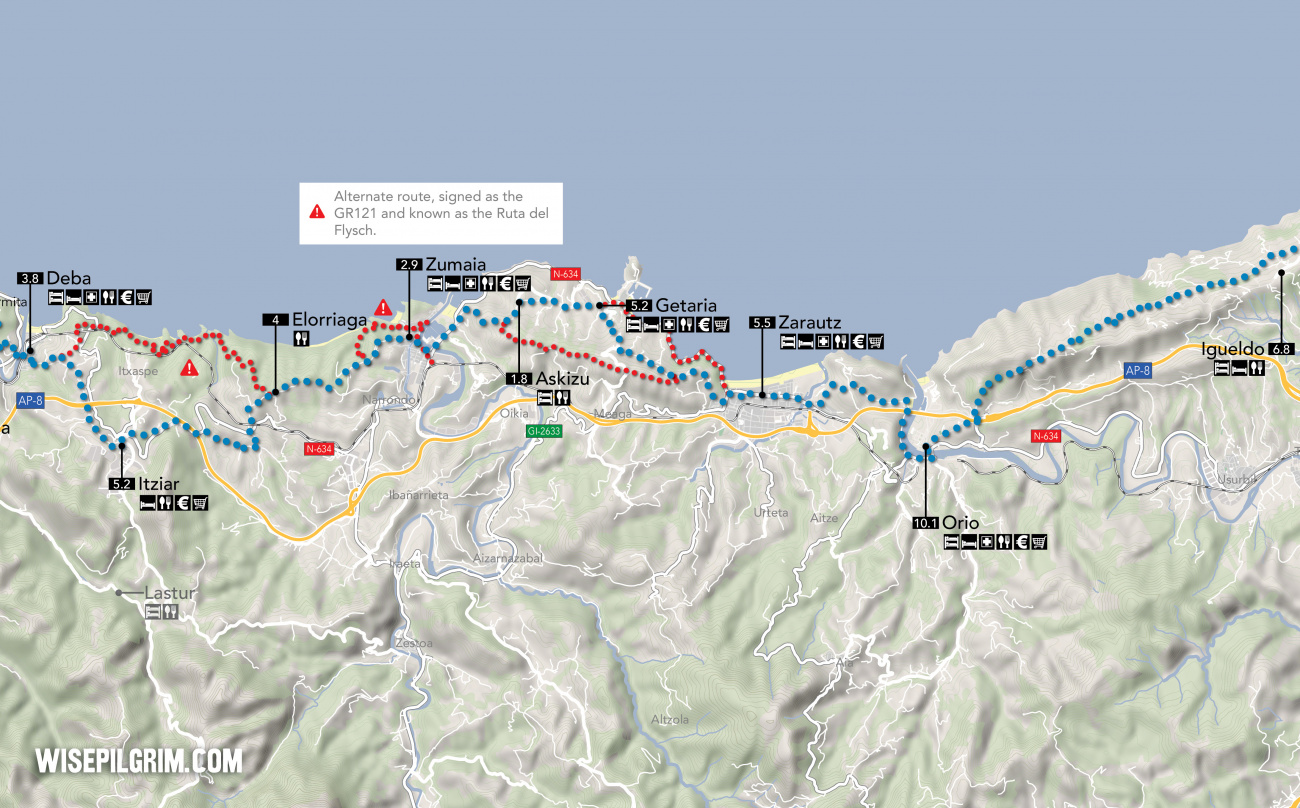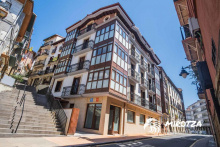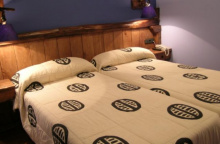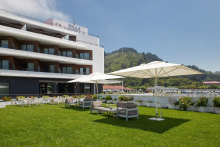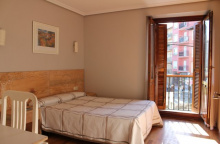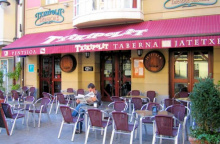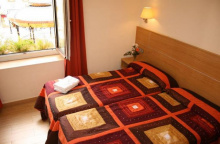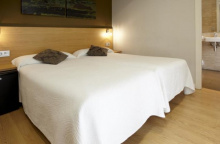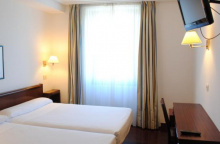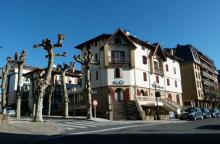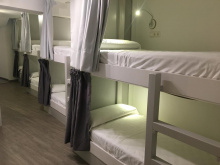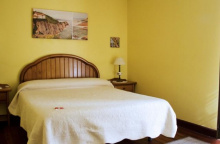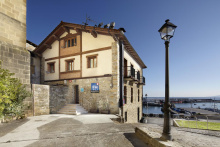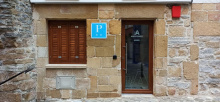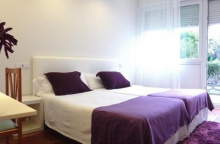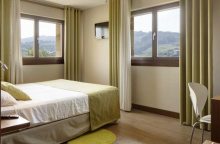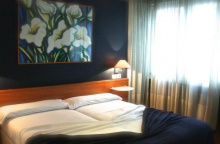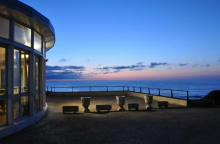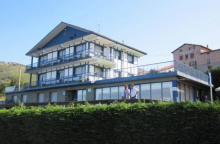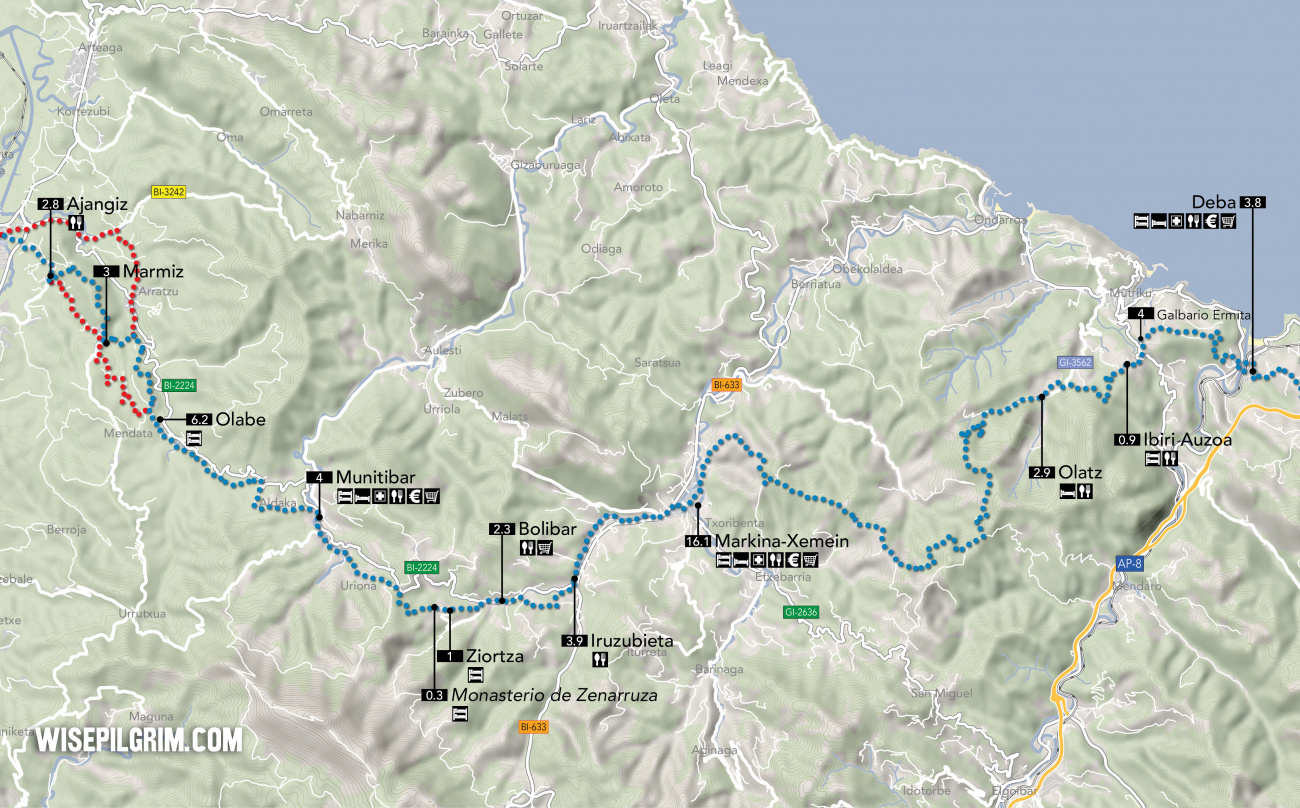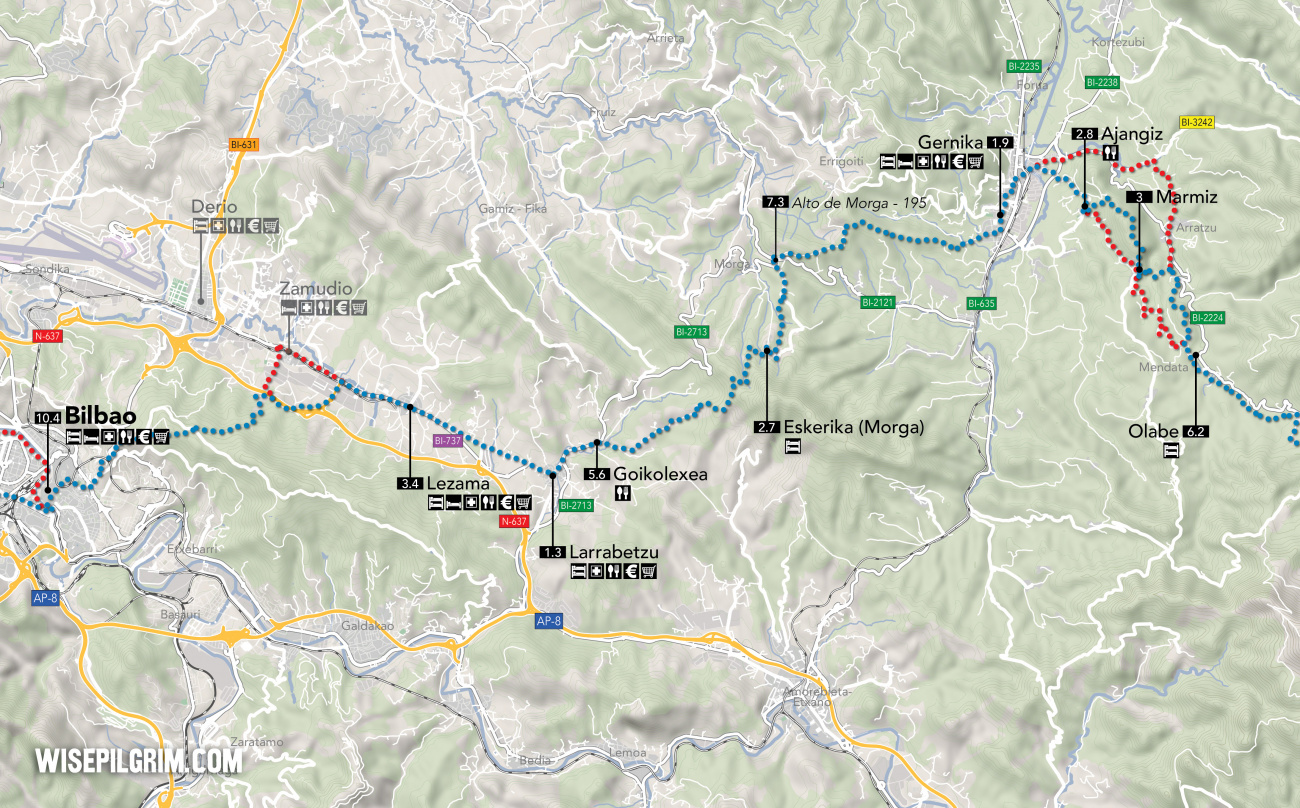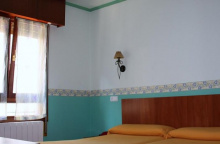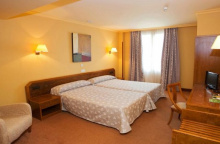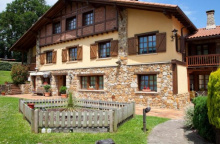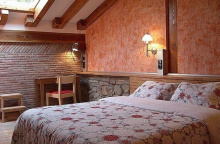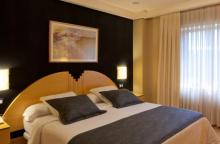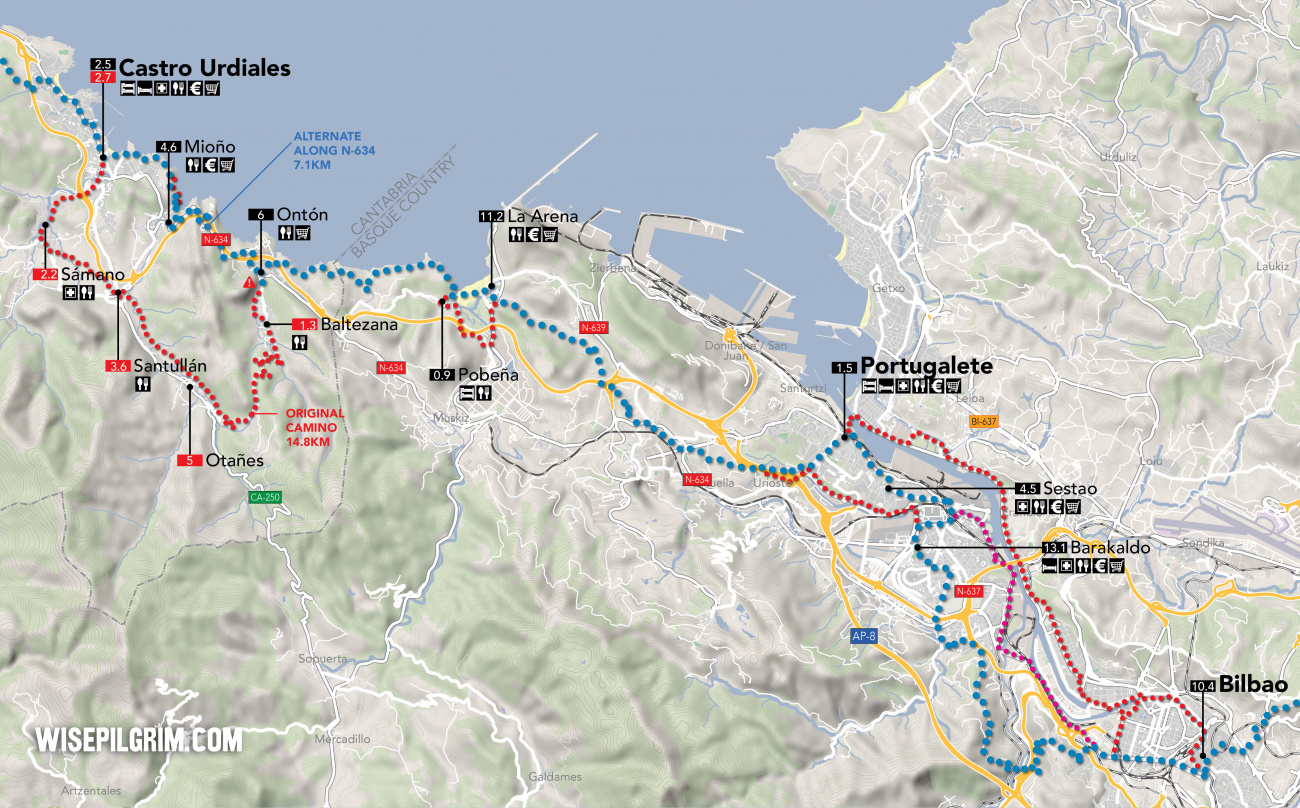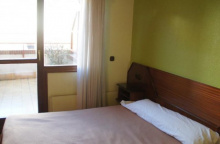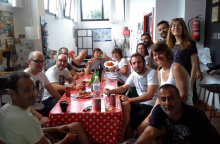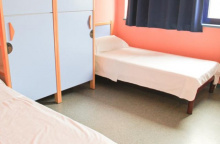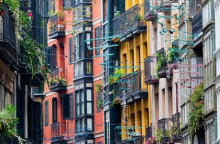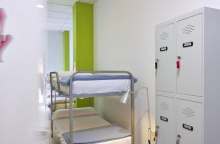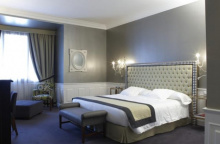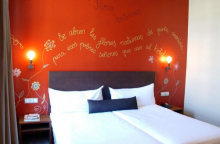The Camino del Norte
In the Basque Country
▶ The Norte in the Basque Country
The Norte in Cantabria
The Norte in Asturias
The Norte in Galicia
Accommodation Directory
The city of Irún, on the west bank of the Río Bidasoa, is the first Spanish city on the Camino del Norte; though it might be more accurately referred to as the first Basque city west of the river. To the east is France, and if your inbound flight landed there your connecting train will cross the border without difficulty.
The bridge over the river here is called the Puente de Santiago and it is the traditional starting point. Be that as it may, the arrows are scant city wide so you will have to be alert and you may well need to ask around. Otherwise follow the signs towards the Estación Ferrocarril de Irún (train station, often abbreviated ff.cc.) and then follow the directions below.
Irún’s more notable churches include Nuestra Señora del Juncal (which holds the oldest statue of the Virgen in the region), the Ermita de Santa Elena (one of the oldest buildings in the city), and the hilltop (views!) Ermita de San Marcial.
The name Irún is often confused with Irúña (the Basque name for Pamplona), something to keep in mind when booking tickets.
Irún is also the starting point for the Basque Interior Camino, which travels southwest to join the Camino Francés in Santo Domingo de la Calzada or Burgos. Do not confuse the two, you are heading northwest from Irún.
Irún, Irúña, and a third city named Iruña de Oca were the three most important outposts of the Roman empire in the Basque territories. Two significant battles took place here; the first and second battles of San Marcial. In the Summer of 1522 the local Basques, numbering less than a few hundred, defended the city from capture by the 3,000 strong mercenaries led by the King of Navarra to the South. Centuries later their ancestors determined to defeat, with the help of Spanish troops and the Duke of Wellington, the Napoleonic troops.
Of the major port cities along the Basque coast, Irún is the least developed. What it has lacked in industry though it has made up for with cross border trading; since the 19th century, the rail lines between the two countries have run on different gauge tracks and to this day both people and goods require a transfer.
The fiestas of San Pedro and San Marcial, known collectively as Sanmarciales, are held at the end of June. San Marcos is celebrated on the 25th of April.
Getting started in Irún is easiest from the train station or the municipal albergue, both are located in the Barrio San Miguel (though there is no church dedicated to the Saint).
From the terminal head straight towards the dome of the nearby Iglesia San Gabriel and Santa Gema, passing the Correos (post office) along the way. Continue straight past the church to the first intersection with a traffic light, the Paseo Colon.
From here you have two choices:
1. The old town of Irún; turn right and over the tracks to get to most of the churches, parks, and hotels.
2. The municipal albergue and the camino; turn left and you are officially on the camino. At the first roundabout the camino continues straight and heads under the overpass. Alternatively, turn right at the roundabout to get to the municipal albergue.
When the opportunity to cross to the left-hand side presents itself do so; the camino turns left 500m ahead immediately after crossing the river.
NOTE: If going to Hondarribia was your plan, keep going straight after the bridge. Once you have left the main road, the camino begins the climb, first on secondary roads and then on trails, to the Santuario de Guadalupe.
Accommodation in Irún
| Albergue de peregrinos Jakobi Donativo€ 60 |
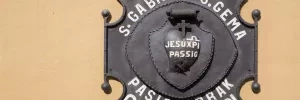
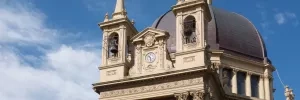
Set off a short distance from the Camino, Fuenterrabía (Hondarribia) is none-the-less considered an important camino city. The old town is centered around a small hill overlooking the Txingudi Bay, and the suburbs and the Donostia Airport have spread outwards from it along the flat sandy plains. In many ways the historical center is more impressive than that of Irún; it preserves many portions of the fortified Muralla de Hondarribia (the wall), the Puerta de Santa Maria (the city gate), as well as numerous churches and plazas.
If accommodation is full in Irún, look to Hondarribia for a perfectly good alternative.
It is said that the Apostle himself passed through Hondarribia on his way to Galicia.
June: A Medieval market is held on the second Sunday of June.
July: Santiago is celebrated on the 25th of July.
August: Several neighborhood fiestas on the 15th to celebrate the Assumption of Mary.
October: San Francisco de Asís on the 5th.
The Santuario is maintained by an Italian fraternity and the hours are limited; if you spot an open door duck in.
It was built in the 16th century and is home to the Black Virgen that was discovered on this hillside by two children. It also displays some high flying ships, a reminder to the faithful that the virgin provides safe harbor to the men who work the seas.
Along a side road behind the Sanctuary is the well-concealed Forte de Guadalupe. It was built at the tail end of the 19th century; a distinction which makes it one of the last of its kind to be constructed and one of the first to be rendered obsolete by fighting planes.
ATTENTION: Do not underestimate the steep climb of 600 meters to the summit of the Jazkibel, take plenty of water and something to eat with you and keep in mind that you will be on the way for several hours to the next place.
La Virgen de Guadalupe is celebrated on September 8th.
The way from the Santuario splits into three, one road and two trails. There is a sign and a map illustrating the differences. The official camino follows a trail just to the south of the ridge line, while an alternative known as the Purgatorio Route follows along the ridge line. Both routes are through fairly remote mountainside.
The Purgatorio route reaches 645m at the Jaizkibel peak and offers views of the ocean. The descent into town brings you directly to the main road, a narrow street that hugs the coastline. On your right is the small boat landing and the ferry across the harbor to San Pedro.
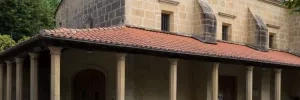
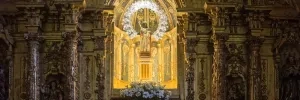
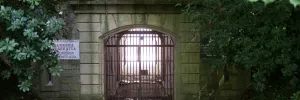
The two Pasajes sit on opposite sides of the river, a narrow stretch that is crossed quickly by a small ferry. The albergue is located high up on the hillside. If you are a fan of fresh seafood the Falcon Crest restaurant on the San Pedro side has a decent reputation.
June: San Juan on the 24th and San Pedro on the 29th. July: The patron, San Fermín, on the 7th. Followed by Santiago on the 25th and San Pantaleón on the 27th.
Accommodation in Pasajes de San Juan
| Hospital de peregrinos Santa Ana Donativo€ 14 |
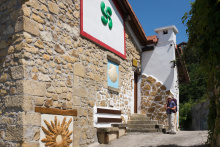
|
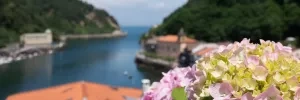
Once off the ferry, the official camino turns right while a road variant turns left. Turn right to follow the coastline to the sea, passing a boat yard along the way. Where the road ends, the path and climb (on steps) begins. At the top the camino returns to a paved road, turn right when it does and follow it until it widens into a parking lot for the nearby Faro de la Plata (straight ahead if you want to visit).
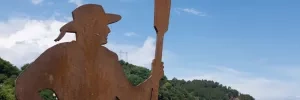
The lighthouse here, along with another on the east bank of the passage, were built to guide ships through this narrow passage at times of rough seas and turbulent weather; once through though the ships enjoyed the calm of the well protected harbor which even today is one of the most heavily used in Spain.
From the parking lot the camino turns left to return to a trail. Pay close attention to the various forks in the trail; although they are well marked there are many options through the forest.
Along this stretch you will also see markings for the GR-121, a 300km circuit that shares ground with the Camino and on several occasions offers an alternative to the official camino.
You will eventually come to a fork in the trail at a point where indeed the GR-121 turns right where the camino turns left. Both are acceptable, the GR follows the coastline through the forest while the camino joins the paved road. They converge before arriving in San Sebastián.
NOTE: Only the camino path passes the Ulía albergue which is located on the hillside overlooking the city. The trail descends into San Sebastián, and where it meets the Avenida de Navarra the municipal albergue is on your right.
San Sebastián is one of the best-known tourist destinations in all of Spain, and is the capital city of the Basque province of Guipúzkoa (there are two more provinces in Spain and three in France). The city is home to about 200,000 people and twice as many more annual tourists, who flock to the Cantabrian seaside to enjoy the sands of the La Concha beach as well as the many international festivals to films and dance that are held here annually. This despite being one of the rainiest cities in Spain (a point which offers little consolation to rain-soaked Santiago).
It is the first major city along the coast where you will find, primarily in the Parte Vieja (old town), the celebration of food that Basque chefs take such pride in. Known as pintxos (bites), and washed down with txakoli (the local white), they display a boggling amount of culinary genius. Get a taste here, and then run wild in Bilbao.
Take in the sites too. The namesake of the town, a monastery to San Sebastián Martír, no longer exists but in its place stands the former summer home of Isabella II, the Miramar Palace. Though you may not get to visit the inside, the surrounding park is a calmer place to take in the views than are the beaches that flank it.
Also worth a visit is the Catedral de Buen Pastor, a neo-gothic gem dedicated to the Good Shepherd whose interior will delight even more than its exterior. If you are feeling ambitious make the climb (or take the cable car, no judgment here) to the top of Monte Urgull where you can visit the Castillo de la Mota or the museum (not much help to non-Spanish speakers) or simply take in the views.
San Sebastián was founded in the late 12th century by King Sancho (the wise) of Navarra to be its principal maritime port. This was useful to Sancho, but to the people of the town it was of little benefit to support a kingdom with so few opportunities to expand. In less than a few decades it was wrestled away by the Kings of Castile, whose thirst for a naval fleet suited and fed the locals better. The locals in the meantime enjoyed the Navarran traffic as well, for Sancho didn’t have much choice. Business was so brisk in fact that the city was rebuilt a half-dozen times after massive fires left it in ashes.
It wasn’t until after the last fire, in 1489 (so around the same time that typhus was getting started on the peninsula), that the city’s future was seriously reconsidered. The result was much more than a change in material from wood to stone, but also in mission. The city lost its mercantile flair, and that business was diverted to Bilbao and Pasajes. The void was filled by the military. Fortresses were built, a navy was stationed, and for the next 4 centuries San Sebastián defended against attacks from many fronts. Some battles were won, many were lost, and the last time the city could be considered occupied was when the Fascists took the town during the civil war.
Although a bit too early in the year for the majority of passing pilgrims, the Tamborrada is held on the day of San Sebastián, January 20th.
August makes up for the rest of the year with the Assumption of Mary on the 15th followed by the Basque Fiestas at the end of the month through the start of September.
Turn right on the Avenida de Navarra towards the sea, the road follows it and you follow the road. You can walk in the sand of the Playa Zurriola if it suits you, the way ahead is evident as it crosses the bridge over the Río Uramea.
Once over the bridge continue straight ahead, past the municipal gardens and towards the Playa de la Concha which you will follow all the way to its end. At the end of the beach cut across the park separating it from the road (Satrustegi) and turn right on the road towards the tree covered hillside ahead, and then left where it ends to follow the road signs to Igueldo.
The Ondarreta Albergue is along this road, straight ahead and on your left-hand side. The camino, however, turns right off of the road before it arrives at the albergue. The way is uphill along a paved road which turns into a trail, twisting and turning all the way to the top. Before long you will be on a small paved road which connects with a larger one, and in front of you will be the gravel parking lot for the hotel Leku Eder, cut across it and walk past the hotel along the main road.
NOTE: If you were to turn right at the parking lot, you could go uphill to visit Monte Igueldo. Follow the road as far as the next hotel, turning right at the sign for the Buenavista Hotel at the start of Igueldo.
Accommodation in San Sebastián
| Albergue Juvenil Ulía 17-25€ 54 Booking.com |
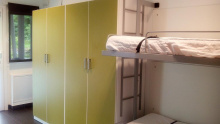
|
| Albergue juvenil Ondarreta - La Sirena 16-23€ 100 |
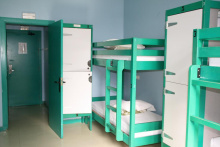
|
| Pensión San Fermín ⭑ Booking.com |
|
| Pensión Donostiarra ⭑⭑ Booking.com |
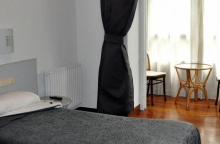
|
| Pensión Artea ⭑⭑ Booking.com |
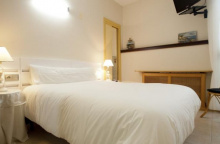
|
| Pensión Kaia ⭑⭑ Booking.com |
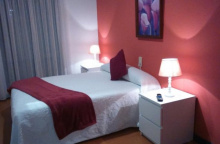
|
| Downtown River Hostel 30/40€ Booking.com |
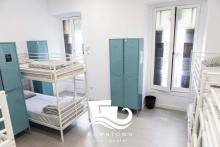
|
| Koba Hostel 20+€ Booking.com |
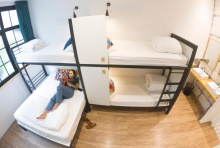
|
| Hostel A Room In The City 18+€ Booking.com |
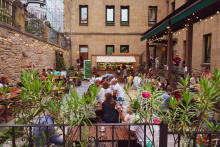
|
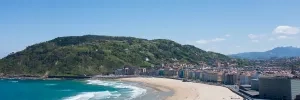
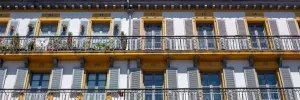
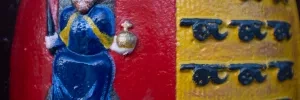
There is a lighthouse here as well as a watch tower. There is also a small amusement park for children. The real draw though is the views. The easiest way here is via the funicular railway from San Sebastián.
Getting from the monte to the camino is a simple matter. From the parking lot at the top of the monte, make like a car and roll downhill along the road. When you get to the small gravel parking lot on your right, cut across it to pass the Hotel Leku Eder and keep on that road.
Igueldo as a territory occupies the whole of the massif and the views along it are grand. All services are located along the main road, south of the camino.
From the Buenavista Hotel the camino keeps to the paved roads for several more kilometers but eventually heads back into the forest along trails and even along centuries old cobbled roads as it descends to the AP-8. After passing under the AP-8 turn right to follow the road steeply uphill. At the top is the Iglesia de San Martín. Follow the road straight into Orio.
Accommodation in Igueldo
Orio has a pretty small center, as it is stuck between the river and the hills. The primary industry in these parts is still fishing and the specialty in Orio is grilled bream. In centuries past pilgrims crossed the river here by boat.
The local church is dedicated to San Nicolas de Bari, patron of fishermen and a well known Saint among pilgrims.
The Day of the Fishermen, San Pedro, is celebrated on the 29th of June. The patron of Orio, San Nicolás de Bari, is celebrated on the 6th of December.
The camino reaches the riverfront and turns left (inland) towards the nearest bridge over the river. Once across the bridge, it turns right to follow the N-634 a short distance. Where the road bends left, the camino exits to the right to follow the waterfront and the Portua. Stay along the road and head towards and under the AP-8 visible in the distance. Once past the bridge overhead, the camino reaches a small beach (on your right). Turn left at the first road, keeping the tall hedge to your left. Follow this road all the way past the Gran Camping de Zarautz; the way is uphill as you climb Mount Talaimendi. As you begin to descend along the road, with Zarautz visible in the distance, the camino turns right towards town along a foot path. It meets the road and turns right.
Accommodation in Orio
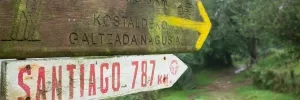
The beach in Zarautz, which is not on the marked camino, is the longest beach in the Basque country. This Queen of Beaches as it is known is the largest tourism draw to the town and every Summer the city fills with thousands of surfers who come to compete. The palaces that once lined the beach have all been replaced by apartment blocks but the fort-like Iglesia de Santa Maria la Real still stands. Adjacent to it is the Torre de los Zarautz which is both the bell tower and Museum of Art and History. Inside the church is a tomb to an unknown pilgrim who, realizing his condition was not well enough to get to Santiago, requested an anonymous burial here.
Zarautz is a popular event town and plays host to several surfing competitions and bike races throughout the summer. Both can put a crunch on the number of beds available.
Very little of Zarautz’s famed fishing past remains. The men here were the dominant whalers of their time until the whales disappeared from the Bay of Biscay. During the 19th century, when seaside palaces were the rage, the bourgeoisie built them here along the promenade.
January: San Sebastián on the 20th, as well as a few wine celebrations throughout the month.
February: Santa Águeda, patroness of the Basque Country, on the 4th. The town also celebrates Carnaval.
May: Santa Marina is celebrated on the 21st.
June: San Pelayo from the 25th to the 27th.
July: Santiago on the 25th.
August: Santa Clara on the 12th, and La Virgen from the 14th to the 16th.
September: Semana Vasca, or Basque Week, from the 1st to the 9th.
The marked way through Zarautz is along the Nafarroa Kalea, about two blocks from the waterfront and parallel to it. As an alternate, you can turn right towards the beach and follow it to the end of town.
Leaving Zarautz can be a confusing affair and the local information office doesn’t do much to clarify matters.
There are two options out of town:
Option 1: The Official Camino to upper Getaria - 5.2
The official camino through the hillside; this option also splits so read ahead to find out more. At the end of the beach or road turn left (south, away from the sea) onto San Inazio Kalea. Keep to the right-hand side and continue a short distance, keeping an eye out for the small road that ramps up to the right and nearly parallel to San Inazio. That road is the one you want, and it will take you upwards.
Near the top, there are signs for the Ermita de Santa Barbara (and an excellent view back east). Not far from the Ermita the camino leaves the road along a path to the right which offers views of the sea. A short distance down this trail the camino joins a different paved road and quickly arrives at a junction. At this point, you have the option of bypassing Getaria entirely. Keep straight for Getaria, or turn sharply left to follow the GR-121. This second option rejoins the first slightly beyond Askizu.
Option 2: The road to lower Getaria - 4.1
The alternate road route along the N-634 coastal road to Getaria. At the end of the Nafarroa Kalea or the end of the beach, turn right and follow the pedestrian path adjacent to the road as it hugs the coastline all the way to Getaria. Simple and straightforward.
Accommodation in Zarautz
| Zarautz Hostel 20-30*€ 24 Booking.com |
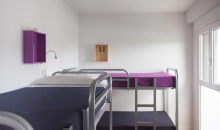
|
| Blai Blai Hostel 24+€ 24 Booking.com |

|
| Kein Hostel 30+€ Booking.com |

|
| Albergue Gran Cámping Zarautz | 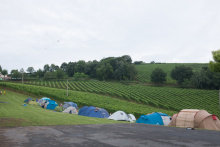
|
The old town of Getaria sits on the shallow bit of land that leads from the mainland to the Monte San Anton and is small enough to take in on your way through town.
Do spend at least a few minutes visiting the Iglesia de San Salvador, whose wonky sloping floor makes for a curious feel.
On the other end of the cultural spectrum, fashionistas or lovers of curated collections should visit the Cristobal Balenciaga Museum.
April: San Prudencio on the 27th.
May: Antxoa on the 3rd, San Isidro on the 4th, and the Day of the Fisherman on the 5th.
June: San Juan on the 23rd and 24th.
August: San Salvador on the 6th.
November: San Martín on the 11th.
If you came into Getaria along the N-634 you will have to climb up to rejoin the camino.
If you came into Getaria along the trail you will have to decide whether you want to descend into town (and then return) or whether to keep on walking.
The camino passes the Kanpaia Albergue at the highest point in town and continues along country lanes. It passes the Ermita de San Prudenzio (300 meters off the trail, has a fountain but is usually closed) and brings you directly to Askizu.
Accommodation in Getaria
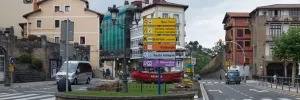
At the far end of Askizu the camino forks at a house, turn right. The trail here affords excellent views of the sea. It will begin to descend, passing the Playa de Santiago far below. At sea level it rejoins the N-634 along a pedestrian walkway into Zumaia.
The walkway bears right at the river to cross along a foot bridge. Once over the bridge it turns right through a small park to arrive at another footbridge over a different river and into the old town of Zumaia.
At the far end of Askizu the camino forks at a house, turn right. The trail here affords excellent views of the sea. It will begin to descend, passing the Playa de Santiago far below. At sea level it rejoins the N-634 along a pedestrian walkway into Zumaia.
The walkway bears right at the river to cross along a foot bridge. Once over the bridge it turns right through a small park to arrive at another footbridge over a different river and into the old town of Zumaia.
Accommodation in Askizu
| Albergue Agote Aundi 15€ 12 |
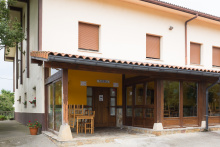
|
The city is poised on the west bank of the confluence of two rivers, so there are naturally a few bridges to cross. It is after the second crossing that you get to the oldest part of town, the monuments, and the best food.
In the center stands the Iglesia de San Pedro Apostol, austere but with some oil paintings of 15th-century merchant ships and a few side chapels. On the north end of town, near the coast, is the Ermita de San Telmo.
Between these two buildings, it is at the latter where you are likely to find throngs of tourists and the occasional tour bus. Sure San Telmo has a devoted following, but the majority of these tourists are snapping selfies at a famous film location (the wedding scene in the top-grossing Spanish film Ocho Apellidos Vascos). The same is true for the fountain and statue of San Juan Iturria.
San Pedro on the 29th of June.
Just over this second footbridge, the camino splits. The official camino continues straight ahead and upwards through town. The alternate route again follows the GR-121 by turning right. They rejoin within 3.5km.
The alternate route, known as the Ruta de Flysch because it crosses the sedimentary rock formations characteristic of this coast, is way marked and passes the Ermita de San Telmo. Both routes pass a public restroom shortly before arriving in Elorriaga.
Accommodation in Zumaia
| Albergue Santa Klara 30€ 16 |
In Elorriaga the camino splits again. The GR-121 turns off to the right just before you get to the bar in town, and follows the coastline once more and in doing so it does not pass Itziar.
The official camino follows the road out of Elorriaga, descending towards the N-634. Cross with care here, the traffic moves fast around the bend in the road. The camino continues up the road on the opposite side. The way is well marked and will bring you back around to meet and follow the N-634 (bar). At the bar it crosses over the AP-8 and continues along the N-634. Try to keep to the right-hand side along this stretch because the camino leaves the road to follow a quieter path on that side. It will again meet up with the N-634, this time at a large junction. The village of Itziar is on the hilltop on the opposite side of the N-634, the Santuario church tower is visible from a distance. Climb up the road into Itziar, following the most direct route to the church.
The name Itziar, and a few derivations of it, is a popular name given to Basque women. Its origin goes back to the 8th century when a temple was built in reverence to Santa Maria de Itziar. Her statue remains here, and is venerated as much by sailors as by pilgrims.
From Itziar the camino turns north to return to the sea at Deba. Past the church turn right at the first fork and follow the country lane. You won’t notice any more highways as you wind your way towards Deba, but they are none-the-less tunneling beneath you.
Accommodation in Itziar
| Agroturismo Donibane ⭑ | 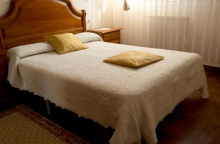
|
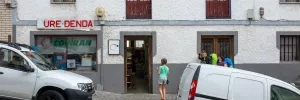
Located about 5km off of the camino, but there is an albergue here. The owners will drive you back to the camino in the morning if necessary. A very quiet mountain location.
A small and compact town with a large beach, and one of the few towns along the way built on terrain so steep that elevators have been installed to help people get up and down. The Ermita de San Roque, on the hillside, is along the camino as you descend into Deba.
There are a lot of architectural gems here, more than you would expect from a town this size. The Iglesia de parroquial de Santa María and the Santuario de Icíar are the obvious ones, but some municipal buildings and even the bridge out of town are deserving of a second glance.
Wave goodbye to the sea. It will be exactly 80km before it returns into view in Bilbao. Between here and there are several mountainous stretches.
Not many ships come to Deba these days, but that has not always been the case. Because of the Ermita de San Roque, it was once a popular starting point for pilgrims arriving at the peninsula by sea.
San Roque is celebrated from the 14th to the 18th of August.
The camino and the GR-121 alternate route meet in Deba near the ermita. The camino crosses the river along a footbridge near the train station and on the opposite bank turns right. A short distance later it crosses the road and just beyond that it turns left, going upwards once again along a combination of well marked roads and paths.
Keep to the marked camino at this point, ignoring all other trails until you reach the Galbario Ermita.
Accommodation in Deba
| Albergue de Deba 8€ 56 |
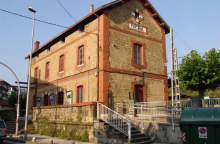
|
| Pensión Zumardi ⭑⭑ Booking.com |
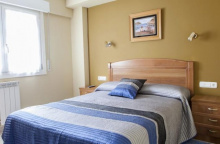
|
Excellent sea views and a suitable place for a rest, the ermita is ordinarily locked up.
The camino joins the road when it reaches the ermita, and follows it to the small village of Ibiri Auzoa.
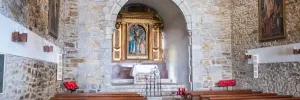
The bar is in the albergue, and opens at 12:30.
Just beyond the Albergue and bar turn left at the fork to follow a trail instead of the road. You will rejoin the asphalt road shortly before Olatz.
Accommodation in Ibiri Auzoa
| Albergue Izarbide 15€ 32 |
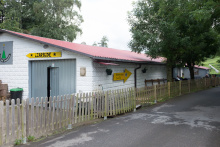
|
The distance from Olatz to Markina is without services of any kind. Be sure to re-fill your water here.
Follow the road past the bar and small park, and when it forks keep to your right uphill on the narrower option. From here to Markina the camino twists and turns quite a bit. It is countryside walking all the way to Markina, where a steep descent brings you into the city from the north.
Having left the province of Gipuzkoa behind, Markina-Xemein is the first city of note in Viscaya.
There are a number of monuments in town, thanks in large part to the pilgrimage route.
They are the Convento e Iglesia de la Merced, Santa María de la Asunción de Jeméin, and San Miguel de Arretxinaga. If you are only going to visit one make it San Miguel, the hexagonal church was built around a megalithic rock formation which dominates the interior and it satisfies the very definition of unique.
Equally revered (by the Basques) are the two-sided frontón courts where the men come to play jai alai (Basque for ‘joyful party’). The municipal court here has produced so many players of international fame that it has earned the nickname the University of Pelota.
Market day is Thursday, in the Plaza del Mercado.
June: San Juan is celebrated on the 24th and San Pedro the 29th.
July: San Martín on the 7th, San Cristóbal on the 10th, and San Ignacio de Loyola the 31st.
August: Goerria on the 1st, Nuestra Señora de las Nieves on the 5th, and San Jacinto on the 17th.
September: Nuestra Señora de Erdotza on the 8th and San Miguel Arcángel on the 29th.
October: Santa Teresa de Jesús on the 15th.
The marked camino passes the church and convent and turns right at the first street past them. Follow the road across a small river and turn left at the first road, keeping close to the nearby building to follow a park trail as is wiggles its way along the river. The camino will take you back over the river (though it is covered so you might not notice) and then under the BI-633. It follows along a smaller river past an industrial park and into Iruzubieta.
Accommodation in Markina-Xemein
| Albergue Intxauspe 14€ 16 |
| Albergue de peregrinos Convento del Carmen Markina Donativo€ 40 |
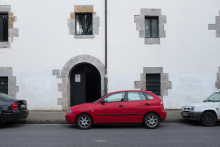
|
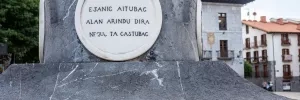
You will enter town from a back road. There is a car park on your right when you get to the main road. Turn left here (facing east) to get to the bridge over the river. Cross the river and then turn right again, quickly followed by another right to leave the road and the town. More mountain roads will deliver you to Bolibar.
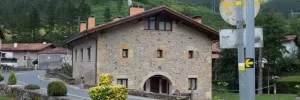
Simón Bolívar, leader of many South American independence movements and namesake to both Bolivia and the Bolivarian Republic of Venezuela, was not born in this town which carries his name and a monument and a museum dedicated to him. Neither were any of his relatives, but as things go they were born near enough to adopt the name of the village as their own. Some 800 years later the name Bolivar became synonymous with liberation, and from these parts come a great many freedom fighters.
At the roundabout at the start of town, follow the road sign to Urua (the only option which crosses the river). This is only to get you off of the main road, which you could just as easily follow to the end of town. The camino passes the Simon Bolivar Museum and arrives at the church where it crosses the main road, and shortly after another smaller road.
From here it is back into the countryside. The camino next meets the road in the two building town of Ziortza, if you plan on staying there turn left at the road. The only buildings in town are visible from here.
Accommodation in Bolibar
| Albergue Usandi Auto Check-in 15€ 26 Booking.com |
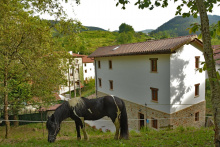
|
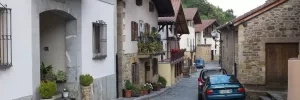
Where the camino meets the road in Ziortza, it is 50m to your left to the bar or less than 300 to your right to get to the Monastery.
On the west gate of the Monastery is a relief carving of an eagle carrying a skull, not a traditional motif for any building but one that illustrates the story of the monastery’s early days. On the day of the Assumption in 968, residents of a nearby Munitibar (the next town on the camino) were celebrating mass when an eagle flew into an open tomb and made off with the skull. They tracked the bird to this spot, where he released the skull. Recognizing divinity when the saw it a church was built, which grew to sustain a town and by the 14th century work on the monastery had begun.
Beyond the monastery the camino turns right and into the forest again.
Accommodation in Monasterio de Zenarruza
| Albergue de peregrinos del monasterio de Zenarruza Donativo€ 21 |
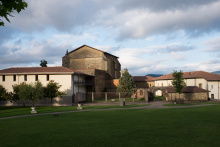
|
If you ask the locals, or don’t since they will none-the-less volunteer their opinion, Munitibar is the very heart of the Basque country. It kind of feels that way too.
The old trading routes once passed through here, sending wool and wine from Logroño up to the sea while hauling back fish on the return trip.
January: San Vicente on the 22nd.
June: San Pedro on the 29th.
July: San Cristobal on the 10th.
September: Nuestra Señora de Gerrikaitz on the 8th.
After crossing the main square in Munitibar, the camino turns left at the church to follow the main road out of town, though only for a short distance. Less than 50m beyond the river it turns left up a side road, climbing up to and beyond the Ermita de Santiago. From the ermita it descends towards Olabe.
Accommodation in Munitibar
| Casa Rural Garro Booking.com |
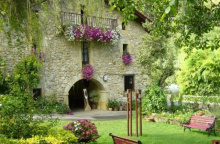
|
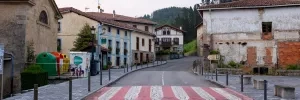
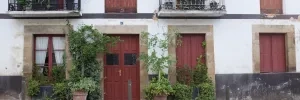
There are several points along this stretch of the road where you may see an errant arrow or two pointing in a direction which doesn’t feel like the camino. This is because in years past the camino followed a different route into Gernika. Follow the freshest arrows and the wooden post signs. The official camino passes the Albergue in Olabe, through the forest to the Iglesia de Santo Tómas. Shortly beyond the church is where the old camino kept to the right and downhill to the nearby village. It now turns left and heads uphill to Marmiz. Note: If you turned the wrong way at the church, and ended up back on the road, there is no need to retrace your steps. There are arrows in the next town which will direct you along the old route to Gernika, a blend of countryside and pedestrian walkways.
Accommodation in Olabe
| Albergue Andiketxe 15€ 20 |
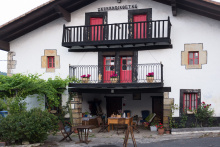
|
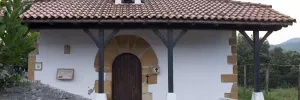
Located 1km off the camino on a marked trail to the left. It is not necessary to return to the camino, as the road from here re-joins it in Marmiz. If you go that way, pay close attention to the turn to the right in town, see below for a description.
Accommodation in Elejalde
| Albergue Municipal Idatze Etxea 7€ 36 |
The camino only touches the edge of town, nearing the main road but turning right before it gets to it. It climbs a bit and traverses the hillside before descending to Ajangiz.
In town the camino crosses the main road to cut through the square and around the church. It will make its way back to the road and follow it all the way down into Gernika, passing a small park just before arriving at the main road.
Upon reaching the main road, the city of Gernika is to your left over the bridge but the private albergue is to your right and well signed.
The tragedies of war have created in Gernika something of an anomalous urban layout; a great many buildings were destroyed, nearly three-quarters of them, and new buildings were shoehorned into their place. It remains pedestrian friendly and is large enough to take up your afternoon.
On your way into town, stop into the Iglesia de Santa María, a Basque Gothic church, and on the way out you’ll pass the Casa de Juntas which can be toured; otherwise just take a pause near the Tree of Gernika, which for centuries served as the meeting places for the Lords of Viscaya.
Between these two are a few museums to explore, but the most important one is the Museo de La Paz (Peace Museum), an exhibition both frightening and enlightening. If you want more Basque culture, visit the Museo de Euskal Herría.
Beyond Gernika the camino is without any services for 15km, pack accordingly.
The names of Gernika and Picasso are inseparable, bound together since the talented artist was commissioned by the Second Spanish Republic to commemorate the horrific events that took place here on an April market day in 1936; it was propaganda at its most artistic level. The massive painting, now on permanent display in the Reina Sofia Museum in Madrid, became one of the most important works of the 20th century but did little to affect the outcome of the civil war.
Andra Mari y San Roque from the 9th to 18th of August.
Monday remains the Market day, as it has for centuries.
Keep going straight after crossing the bridge into Gernika, following the road to where it ends at a large mural recreating Picasso’s famous painting depicting the city under bombardment. Turn left there, uphill and against traffic, passing the Iglesia de Santa María de la Antigua. A few buildings later you will turn right to pass between the park and the Convento de Santa Clara. When this road ends at a larger one, turn left. Further on keep left at the fork in the road, heading downhill to a roundabout.
At this point, you are surrounded by residential buildings on all sides. Go straight through the roundabout to the next one, and turn right when you get to it. Keep straight along this road, and straight again through the park when the road ends in a bend. Past the ermita in the park it is a left turn and a right immediately after, past the last of Gernika’s urban expansion and into the countryside. From here you begin to wind your way steeply up to the Alto de Morga.
Accommodation in Gernika
Mind the traffic at the Alto, which comes faster than expected.
You will arrive at the Alto at a large and fairly dangerous highway crossing. The way ahead is marked, and you are heading towards the signs marked Larrabetzu. After crossing the highway, turn left at the first junction, uphill. You will pass the small Ermita de San Esteban and return to a woodland setting. The next place with a name is Eskerika, but you would not recognize it for much more than a single building.
Accommodation in Alto de Morga
| Albergue Caserío Pozueta 15€ 16 |
|
| Albergue Gerekiz 16€ Booking.com |
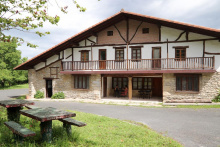
|
Follow the arrows through this place, eventually descending to Goikolexea and the Iglesia de San Hemeterius and Celedonius at the entrance to town.
The Iglesia de San Emeterio and San Celedonio is the most massive building for miles. It, like the Tree in Gernika, was a meeting point for the Lords of Viscaya.
After passing the church and bar at the start of town the camino comes to the main road where it turns left and follows the road all the way to nearby Larrabetzu.
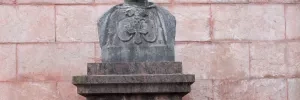
Larrabetzu is one of the most outspoken villages in the Basque fight for independence. The city was a key location in the line of defense known as the Iron Belt. The hillsides here are criss-crossed with trenches and fortified bunkers designed to defend against the capture of Bilbao by the fascists in 1936. The efforts were unsuccessful, but the pro-Basque vision never waned. The city remains painted and plastered with graffiti and banners proclaiming independence for the Basque country and liberty for resistance members currently imprisoned.
San Isidro, the patron of the town, is celebrated on the 15th of May.
The camino turns right at the entrance to Larrabetzu, leaving the main road behind. In town it turns right and begins to follow a different road directly to Lezama.
Accommodation in Larrabetzu
| Albergue de peregrinos de Larrabetzu Donativo€ 20 |
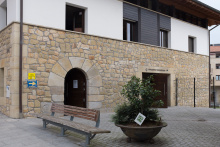
|
| Casa Rural Miamendi Booking.com |
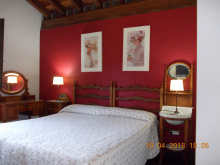
|
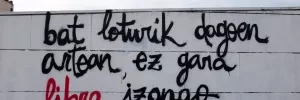
Lezama is the eastern-most village with rail access to Bilbao and the last city before reaching its outer suburbs.
The camino keeps to the main road, passing straight through Lezama. It goes straight through two large roundabouts and turns left at the third to pass underneath the railway lines. After doing so it arrives at another roundabout, on the right-hand side is a trail that will take you under the AP-8. The route ahead climbs over the hillside, affording panoramic views of Bilbao. The way into Bilbao is well marked, and you enter the historic center via the Barrio Santa Cruz.
Accommodation in Lezama
| Albergue de Lezama Donativo€ 20 |
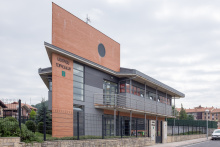
|
| Casa Rural Madarian Booking.com |
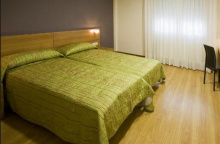
|
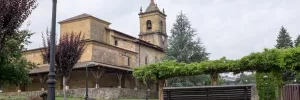
Both Zamudio and Derio are located along the road from Lezama and can be reached by simply keeping straight at the third roundabout mentioned above.
Accommodation in Zamudio
Located 1.5 off the camino in a suburb near the Bilbao airport.
The Guggenheim Museum of Bilbao, a building voted for and funded by its citizens, was the first step in putting this historically industry-bound city on the tourist map. Since its opening in 1997, the city has grown rapidly to accommodate the explosion in visitors.
It is a large city, and while the old town can be seen in an afternoon it would take two days minimum to get around the new town. If you are crunched for time or want to go easy on your feet there are plenty of public transport options; you would do right to avoid the quality metro and stick to the above ground Euskotran tram line (lime green line on the map) which allows you to see the city as you move through it. It follows the 3rd option out of Bilbao and goes as far as the Basurto Hospital on the 1st option.
As museums go, the Guggenheim is not the only gig in town. Nearby is the Bilbao Fine Arts Museum where you will find more religious paintings (and paintings in general). The museum is at the edge of the Doña Casilda Iturrizar Park, which along with the Plaza Nueva and the Plaza Miguel de Unamuno, are great places to relax; though the latter two will do more to fill your belly.
The Basilica de Begoña (formerly dedicated to Santiago) is passed as you descend into Bilbao, which is fortunate because most tourists have to make the climb up to it.
The more notable and accessible monuments are the Cathedral de Santiago (the only Cathedral consecrated in his name), the Iglesia de San Nicolas, the Parroquia de San Anton (which with the bridge adjacent both appear on the Bilbao Coat of Arms), and the Iglesia de los Santos Juanes (Jesuit Baroque).
Though settled by the Romans, the modern city of Bilbao didn’t really take root until the 14th century, alongside the majority of cities along the Basque coastline.
Within a few centuries iron ore would be discovered in the mountains nearby and the city would achieve a level of industrialization unseen anywhere else in Spain. That growth lasted through the civil war and it wasn’t until the 1980s that globalization began to put the economy in a bind. The government reacted quickly, and the economy driving the city as you see it now is fueled by the service industry.
The main festival of Bilbao is known as La Semana Grande (though you will more likely see posters for ‘Aste Nagusia’); it celebrates the Assumption of Mary on the 15th of August. The 9-day celebration kicks off the following Saturday.
The route through Bilbao is not singular. Indeed if you spend any time wandering off the camino (and you should) you are likely to find yellow arrows pointing a way. There is no wrong way, but there are many.
There are essentially three different options ahead; all routes cross the river near the Iglesia de San Antón to leave the old town over the cities oldest and most frequently rebuilt bridge, the Puente de San Antón.
Option 1: The Official Camino
The official camino turns away from the river and crosses the city due west along one of its busiest Avenidas. As it nears the Basurto Hospital it splits, creating the second option below. To keep on the official camino requires you to cross the road to your left to follow a road uphill a short distance before crossing left again to get to the nearby stairs which will take you around the hospital and set you on a course to pass underneath the A-8. From here the camino begins to climb up to the municipal albergue, which is located well out of town on the hillside overlooking the city. The idea here is to go up and over the hillside.
Winding down the other side you will pass under a highway and then over a river before climbing up another hillside. On the other side of this second hill you will descend into Barakaldo, passing several of its suburbs as well as the very large Bilbao Exhibition Center. The camino is well marked and winds its way through the center of Barakaldo. It will eventually bring you to a riverside pedestrian path. Not far ahead, where the path bends to the right, is a confusing split. There is an option at this point to cross the river (left, marked Sestao) and more or less avoid both Sestao and Portugalete altogether, by following a path along the river just to the south of both cities. The option is shorter and flatter and it follows a cycle path. Otherwise, the official camino bends right to follow the river and crosses into Sestao at a different bridge.
Option 2: Through Bilbao but avoid the hills - A new route
Possibly the least traveled option, this route follows the official camino as far as the hospital but keeps on the N-634. It is considerably flatter than the official camino, and only half as long. It is also recently waymarked so you may find it to be more commonly used by the time you get there. It essentially follows the west bank of the river all the way to Sestao, bypassing Barakaldo.
Option 3: Direct to Portugalete on the east bank
After crossing from the old town to the new town, simply follow the road that follows the curve of the river (which means turn right at the end of the bridge). You are essentially walking counterclockwise around Bilbao and will pass the Guggenheim Museum along the way. Beyond the museum you walk through a city park, and cross back over the river at the second bridge. Access to the bridge is elevated, so wind your way up the helical ramp. Once on the other side, wind back down to the road level and head towards the river. From there follow along the park path adjacent to the river. Where the park ends the camino turns to the right (north) at a large roundabout and then left onto the Calle Morgan. A few blocks later the road bends to the right and heads into a tunnel; at the same time the camino is above the tunnel, which is obvious when you see it. At the next road it turns left and then right again, taking you around a large sports complex.
Before long you will arrive at another busy road and turn left. From that turn it is a more or less straight path all the way to the Viscaya Bridge over the river and into Portugalete. This last section follows close to the river and passes through several industrial parks; these are perhaps the only downside to this route. The bridge over the river into Portugalete is probably the highlight of the route. The locals call it the hanging bridge (puente colgante) and it is the first of its kind ever to be built, a distinction which earned it a UNESCO World Heritage Site designation. It operates every 8 minutes.
Accommodation in Bilbao
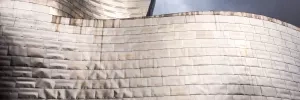
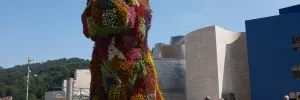
January: San Vicente on the 22nd.
February: Santa Águeda on the 5th.
July: Santiago on the 25th and San Ignacio on the 31st.
August: San Roque on the 16th
October: Santa Teresa on the 15th.
Accommodation in Barakaldo
| Albergue del Polideportivo de Gorostiza Donativo€ 20 |
| Pensión Zeus ⭑⭑ Booking.com |
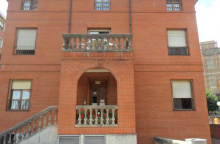
|
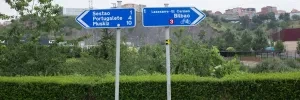
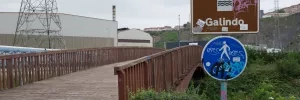
June: San Juan and San Pedro, patrons of the city, on the 29th with a party that runs into the 30th.
July: Santiago on the 25th and San Ignacio on the 31st.
August: Santa Rosa de Lima on the 30th.
Portugalete was once the main competitor to Bilbao’s port, but for reasons unknown, it lost the deal early on. It remains a miniaturized version of the capital.
If you didn’t already come across it, and if you are fascinated by the marvels of civil engineering, follow the signs to the Viscaya Bridge; it is the first of its kind and a UNESCO heritage site.
Other monuments include the 15th-century Basilica de Santa Maria, the Torre de Salazar, and the town hall; and strolling between them all takes you over and under the medieval arches and streets in the old town.
La Virgen de la Guía is celebrated on the 1st of July, San Roque and La Virgen from August 15th to 17th.
The route from Portugalete to La Arena is almost entirely on paved surfaces, and getting out of the expanses of the city require twisting and turning your way around and under the complex network of highways that crowd out green space. Much of the trail is along a dedicated bike path, separated from the highway by a tall glass divider and decorated with the silhouettes of birds. This bike path is part of a larger network of paths that connect many of the suburbs, so pay close attention at every junction. See notice below for possible confusion near La Arena.
Accommodation in Portugalete
| Albergue de peregrinos de Portugalete Donativo€ 30 |
| Albergue Bide Ona 15€ 34 Booking.com |
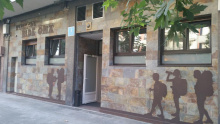
|
| Pensión Buenavista |
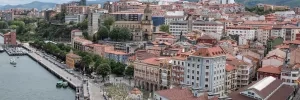
The long boardwalk here makes for a comfortable place to have a pause. All of the bars and shops are on the east end of it.
Just prior to arriving in La Arena, you may notice old arrows directing you to your left. They occur shortly before passing under a bridge and should be ignored. Continue straight into La Arena.
The camino follows the boardwalk in La Arena, where it eventually joins a new foot bridge over the small estuary and into Pobeña.
After crossing the bridge you have the option of going across the parking lot to the town, where you will find the albergue and several restaurants.
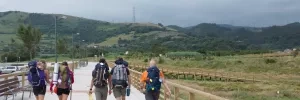
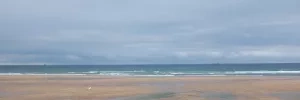
There are several restaurants in this small town, some are fancier than others. Take a quick stroll to scout them out before settling in.
To keep on the camino, do not cross the parking lot. Instead look to your right; just past the Residencia Pobeña is a narrow path that takes you uphill for a beautiful walk along the headlands.
The camino turns inland and passes under the A-8 just before arriving into Ontón, and along the way you cross into Cantabria.
Accommodation in Pobeña
| Albergue de Pobeña Donativo€ 40 |
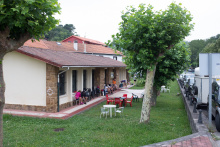
|
